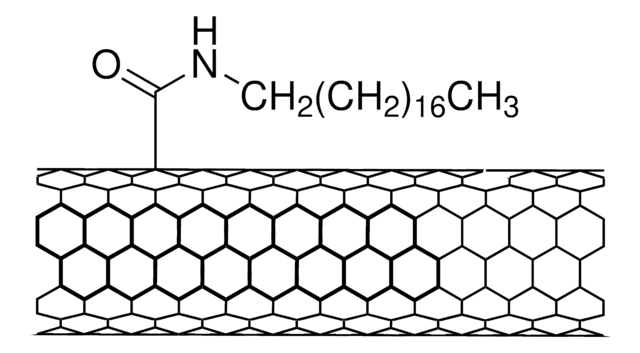724777
Carbon nanotube, single-walled
≥90% carbon basis (≥80% as carbon nanotubes), 1-2 nm diameter, avg. no. of layers, 1
Synonim(y):
CNT, SWCNT, SWNT, Single wall carbon nanotube
About This Item
Polecane produkty
opis
G/D Ratio: ≥15 (Raman 633 nm)
Median length: 1 μm
Próba
≥90% carbon basis (≥80% as carbon nanotubes)
Postać
powder (freeze-dried)
Właściwości
avg. no. of layers 1
producent / nazwa handlowa
Signis® CG200
powierzchnia
≥700 m2/g
zanieczyszczenia
≤5 wt. % Moisture
średnica
1-2 nm
mp
3652-3697 °C (lit.)
gęstość
1.7-1.9 g/cm3 at 25 °C (lit.)
gęstość nasypowa
0.1 g/cm3
ciąg SMILES
[C]
Szukasz podobnych produktów? Odwiedź Przewodnik dotyczący porównywania produktów
Opis ogólny
Zastosowanie
Uwaga dotycząca przygotowania
Informacje prawne
Kod klasy składowania
11 - Combustible Solids
Klasa zagrożenia wodnego (WGK)
WGK 3
Temperatura zapłonu (°F)
Not applicable
Temperatura zapłonu (°C)
Not applicable
Certyfikaty analizy (CoA)
Poszukaj Certyfikaty analizy (CoA), wpisując numer partii/serii produktów. Numery serii i partii można znaleźć na etykiecie produktu po słowach „seria” lub „partia”.
Masz już ten produkt?
Dokumenty związane z niedawno zakupionymi produktami zostały zamieszczone w Bibliotece dokumentów.
Klienci oglądali również te produkty
pandemic influenza A H1N1 virus infectivity of
lung epithelial cells
Produkty
The CoMoCAT® method of single-walled carbon nanotube (SWNT) synthesis yields high purity SWNTs with specific chiralities and narrow distributions of tube diameters.
Composite materials with micron scale reinforcements offer tailored properties for various applications.
Single-Walled Carbon Nanotubes synthesized by the Super-Growth Method & their properties & applications, including dispersing SGCNTs, SGCNT-polymer composites & SGCNT-metal composites are discussed.
Boron nitride nanotubes (BNNT) are close structural analogs of carbon nanotubes (CNT), which are high aspect ratio nanotubular material, where carbon atoms are alternately substituted by nitrogen and boron atoms.
Protokoły
Surfactant-assisted dispersion of single-walled carbon nanotubes for debundling or exfoliation in dispersion procedures.
Nasz zespół naukowców ma doświadczenie we wszystkich obszarach badań, w tym w naukach przyrodniczych, materiałoznawstwie, syntezie chemicznej, chromatografii, analityce i wielu innych dziedzinach.
Skontaktuj się z zespołem ds. pomocy technicznej





